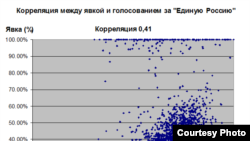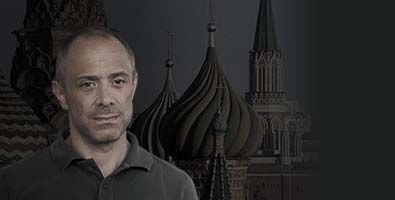Now Russia’s bloggers are at it again, putting the microscope to the official results of the October 11 Moscow City Duma elections, in which, according to official results United Russia won 66 percent of the vote and 32 of the 35 council seats. That’s right, under the grossly unfair seat-allocation system that they instituted before the vote, 66 percent of the vote translates into 91 percent of the seats. Official turnout in Moscow was put at about 35 percent.
A blogger named kireyev posted on his LiveJournal blog an analysis of all the more than 3,000 polling stations in Moscow, using official data from the Central Election Commission. His figures show compellingly that the higher the reported turnout at a particular polling station, the higher the vote total for United Russia was there. That is, all the “above average” votes seem to have gone to the ruling party.
Kireyev then analyzed the 146 polling stations that reported 20 percent turnout or less, figuring that these precincts had the least fraud, at least in the form of ballot-box stuffing. He found that among these stations, the results were: United Russia, 46 percent; the Communist Party, 21 percent; the Liberal Democratic Party of Russia (LDPR), 9.8 percent; Yabloko, 8.3 percent; A Just Russia, 8 percent; and Patriots of Russia, 3.1 percent.
Another blogger, Andrei A., took Kireyev’s numbers a bit further and calculated that the actual turnout for the Moscow elections was about 20 percent and that United Russia polled about 42 percent. He estimated that the average fraud among all polling stations was 15 percent of the ballots, while the maximum fraud reached more than 30 percent in some precincts.
A third blogger, avmalgin, got a hold of the voter protocols for polling station No. 1,702 in Moscow. That document shows 192 votes for United Russia, 98 for the Communist Party, 50 for A Just Russia, 38 for Yabloko, 37 for the LDPR, and 11 for the Patriots of Russia. However, the website of the Central Election Commission, of which the blogger presents a screenshot, shows the exact same results for all the parties – except for United Russia. By official results, United Russia got 742 votes. That is, United Russia’s percentage was magically raised from 45 percent to 74 percent.
These bloggers and others like them are doing brave work. Central Election Commission head Vladimir Churov has already compared those who are reporting on the fraud to "terrorists" and has threatened to prosecute them.
With any luck, though, we’ll be seeing a lot more of this information in the coming days. If you spot any, please forward them to me.





